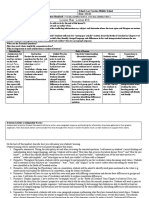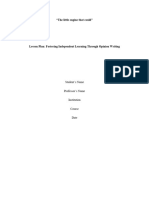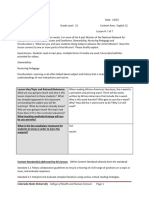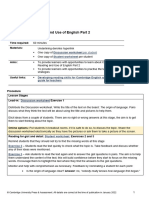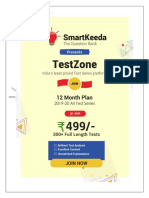Assessment 3 Lesson Plans
Assessment 3 Lesson Plans
Uploaded by
api-222850219Copyright:
Available Formats
Assessment 3 Lesson Plans
Assessment 3 Lesson Plans
Uploaded by
api-222850219Original Title
Copyright
Available Formats
Share this document
Did you find this document useful?
Is this content inappropriate?
Copyright:
Available Formats
Assessment 3 Lesson Plans
Assessment 3 Lesson Plans
Uploaded by
api-222850219Copyright:
Available Formats
LITERACY / UNIT PLANNER Topic: Discussing cultural perceptions GRAMMAR FOCUS: (levels) 1.
Whole text structure of a Persuasive Discussion
Statement of issue Topic sentences Body paragraph for each idea/argument Compares opposing arguments Supporting evidence for arguments Concluding statement
Year Level: 5
Text type and mode Discussion Listened to
Term:
Spoken
Week:
Read Written
Date:
Viewed Produced
Language features for the text-type: 2. Sentence level
Simple, compound and complex sentences. Personal and Impersonal voice. Active and passive voice used. Passive verbs. Action and mental process verbs. Timeless present tense. First, second and third personal pronouns. Signal words (outlining cause and effect).
3. Word level
X X X X X X Steps in Teaching and Learning Cycle: (adapted Derewianka, 1990/2007) 1.Building topic knowledge 2.Building text knowledge/Model the genre 3.Guided activities to develop vocabulary and text knowledge 4.Joint construction of text 5.Independent construction of text 6.Reflecting on language choices Frequently used Literacy Instructional Strategies: Think Aloud Language Experience Approach (R/W) Read to Shared R/W Guided R/W Modelled writing Interactive writing Independent R/W Literature Circles Reciprocal Teaching Mini lesson Roving conferences Reading Interviews Cloze
(Wing Jan, 2009, pp. 170).
Topic-specific vocabulary for the unit of work:
Bushranger, tannery, troopers, stereotypes, social order, education, criminals, eras, decade, timeline, rights, expectations, formal, informal, history, equality, duties, routines, paragraphs, key words, closure, argument, evidence, proof, justify, support, reason, rebuttal.
Thinking Tools/techniques to support chns thinking before/during/after an activity: Graphic Organisers (GO) e.g. Venn Diagram, Y-Chart, T-chart, Semantic grid; Brainstorm; Mindmap; Think-Pair-Share; DOVE; Placemat; Graffiti Wall; Post-it Notes; Sunshine Wheel; A-Z proforma; Problem-solving; Reflective Learning Journals; Share time; Reflection Circles; Role-play; Fish Bowl; Debate; Discussion; PNI; 5VIPs; Bundling; Comprehension Strategies: Predicting; Visualising; Making connections; Questioning; Inferring; Determining important ideas; Summarising; Finding evidence in the text; Understanding new vocabulary; Synthesising; Comparing and contrasting; Paraphrasing; Recognising cause and effect; Skimming and scanning; Question types: self-questioning; 3 levels; (literal, inferential, evaluative) QAR
Resources:
Wing Jan, L. (2009). Write ways. South Melbourne: OUP.pp. 166-182; EPISODE 18 | 1838: DAVEY English teaching resources downloaded on 17 Sept from www.myplace.edu.au/. My Place website www.myplace.edu.au Video clip Episode 18 (2+3); ABC3 MyPlace http://www.abc.net.au/abc3/myplace/
Analysing Checking Classifying Cooperating Considering options Designing Elaborating Estimating Explaining Generalising Hypothesising Inferring Interpreting Justifying Listening Locating information Making choices Note taking Observing Ordering events Organising Performing Persuading Planning Predicting Presenting Providing feedback Questioning Reading Recognising bias Reflecting Reporting Responding Restating Revising Seeing patterns Selecting information Self-assessing Sharing ideas Summarising Synthesising Testing Viewing Visually representing Working independently Working to a timetable
1|Page
TEACHING & LEARNING CYCLE (Identify step in the T & L cycle and the literacy learning intention or sessions focus )
WHOLE CLASS Tuning In (Identify a strategy or a tool to help activate prior knowledge and/or to introduce the topic.)
MINI LESSON (Explicitly model the use of a new strategy or a tool to assist with the literacy learning intention or focus of the session and to prepare students for successful completion of the set task. Reference to Wing Jan include page details)
INDEPENDENT LEARNING (Extended opportunity for students to work in pairs, small groups or individually on a set task. Time for teacher to probe students thinking or work with a small group for part of the time. Reference to Wing Jan include page details)
SHARE TIME AND TEACHER SUMMARY (Focused teacher questions and summary to draw out the knowledge, skills and processes used in the session)
ASSESSMENT STRATEGIES (Should relate to literacy learning intention or focus of the session. Includes how & what you will use to make a judgment on students attempt/work)
Session 1: Point of View.
Brainstorm
Show the Lesson starters Persuasive Text video on school uniforms (00:3002:45) -see Figure 1 Create a T-chart on the board with arguments for and against the use of school uniforms. Enquire into what the students think and discuss which side has the more compelling argument. Focus questions Why are school uniforms good to have? What are the disadvantages of uniforms?
Shared Reading
Explain that the next few lessons will focus on reading and writing discussion texts. Read through the print version of the videos dialogue with the students, noting the overall structure of Statement of issue Topic sentences Body paragraph for each idea/argument Compares opposing arguments Supporting evidence for arguments Concluding statement
Independent Writing
Students write 2 small paragraphs of writing giving their opinions on uniforms in schools. Each opinion should be backed up with a piece of evidence.
Think-Pair-Share
Students sit with their 2 paragraphs on the floor and sit knee-to-knee, eye-to-eye with a partner, the students discuss their opinions and what evidence they have to back it up. Ask a few students to share with the class what their Partner's opinion was and why they thought that. (Did they agree/disagree? Did anyone's opinion change after someone else presented their view?)
Anecdotal notes and worksheet analysis
Collect writing paragraphs from students and assess for strength of argument and proficiency in expressing it. Use results to inform individual student or group foci for next lesson.
EAL Teaching group:
Co-operative learning: Demonstrate to ESL group how the students can start their paragraphs using a given topic sentence to start each paragraph: Having uniforms at school is good/bad because
Focus questions
Which side; for or against, has the better overall case? Why? For each side, which is the strongest argument? Are they based on facts or opinion?
2|Page
Session 2: Planning for a DiscussionText
Shared Reading
Read and discuss the PowerPoint text: should mobile phones be banned in schools (figure 2) with students from the class taking turns to read each half of a paragraph of information. Between each slide, unpack the key arguments in each body paragraph (listed in point form after each section).
Interactive Writing
Brainstorming with the students, extract and record the facts about the topic using a concept map. Decide on a stance to take and list the pros and cons of the issue with a T-chart. With the students, rate the arguments supporting their position as either weak, average or strong (Why does this argument have more weight? Are there any points on the opposing side that nullify one of our points?) Demonstrate how to prioritise arguments, select supporting evidence and anticipate the opposing points. (Adapted from Wing Jan p.177)
Group Debate
Students are divided into 6 groups, with 2 groups being assigned to one of 3 questions: -Should mobile phones be allowed in primary school? -Should students do homework? -Are uniforms good or bad? Each group takes a stance on the issue that opposes their paired group's view. They list all the arguments for their case and rate them for which are the strongest arguments. When all the groups are finished, the class listens to the arguments and evidence. from each group ESL adjustment- assign ESL students to one of the groups working on the mobile phone issue and work closely with them to ensure understanding of the topic.
5 VIPs
Students form into pairs and decide on 5 important ideas about making discussion texts they have learned about that they can write as a list of dot-points. (Includes ESL students paired with nonESL students) Compile a list of each unique point made by student pairs about discussion texts on the class board. Maintain this information either on the board or through a poster that will remind students of what process to follow to plan for a discussion text.
Informal Observation
Monitor the quality/number of arguments listed by each group. There should be a minimum of 4 arguments (with supporting evidence) per stance and at least 2 strong points.
3|Page
Session 3: Structure and language features of a written discussion text. (derived from Davey 1838: Justice activity)
Brainstorm
Watch the video clips: The Bushranger and The shooting. As a class, list the main events in this part of the story. Ask students to think about what happened, why and to whom. Have them share their responses and discuss them, listing the main ideas and key characters involved. Ask students the following questions: -How does Davey see the bushranger in the first clip? -Why do Davey and Alice direct the soldiers, who are chasing the bushranger, in a different direction? -Who are the 'goodies' and 'baddies' in this clip? How do you know? -What laws do you think have been broken and who has broken them in this clip? -How do Australians typically view bushrangers? As heroes or as villains?
Modelled Writing
Model the structure of a short written Discussion based on the issue of Bushrangers. Verbalise the decisions you make as you write the text and the following processes: -Opening statement of issue -Topic sentences -Body paragraph for each idea/argument -Compares opposing arguments -Supporting evidence for arguments -Concluding statement
Independent writing
Students write an opening statement for their point of view on bushrangers and justify their opinion with 2 paragraphs (each one with a supporting piece of evidence)
Whole class reflection
Ask students to pair up with a partner that took the opposing view to their argument. Each student explains their reasoning and they discuss which evidence is strongest. (If not enough students on each side of issue, divide the larger side into small groups containing at least one member of the opposing argument.)
Anecdotal notes and worksheet analysis
Use a checklist to assess the strength of student written arguments by the quality of the supporting evidence and the successful application of the text structure.
EAL Teaching group:
Have students work with a partner to conduct a hot seat role-play, where each student takes turns to be in the hot seat. Have students take turns to question each other about their opinion of bushrangers. Students should justify their statements using evidence. When students have a clear idea of their POV, they proceed to write their statement of intention and one body paragraph of supporting evidence.
4|Page
Session 4: Planning for the writing of discussion texts.
Group Deconstruction
Distribute copies of arguments to small groups of students and have them identify the text structure and features including: -simple, compound and complex sentences. -impersonal voice. -mixes of active and passive language to describe 'doers' of verbs -timeless present tense -signal words Share the findings of the class and create a chart that records their developing knowledge about discussion texts.
Joint construction
Using a whiteboard, jointly construct an opening statement for an issue (i.e. Are video games a waste of time?) and one against the issue. Propose the creation of a set of criteria that the class' texts will be judged by- based on figure 3 Explain that students will be selfassessing their discussion texts as they are completed. Focus questions: -What would the audience need to know about this issue? -what are the opposing viewpoints? -What are the arguments and reasons for one viewpoint? -What are the arguments and reasons for the other viewpoint? -What do you think of the issue? What is your opinion? Why do you think this? (focus question's taken from Wing Jan 172)
Independent Writing
Students select a topic that has been explored previously or from a list of suitable issues and begin construction of a discussion text. They will be expected to complete an opening statement, take a position on the issue and write their first body paragraph (one argument and at least one piece of supporting evidence.) Teaching group with small group of EAL: Outline examples of appropriate expressions when they are needed. Providing sentence beginnings and a list of connectives to help link ideas (figure 4) note down a few students to share their work with the whole class after think-pair-share.
Think-Pair-Share
Students sit with their 2 paragraphs on the floor and sit knee-to-knee, eye-to-eye with a partner, the students take turns to describe the issue they have chosen and the position they have taken. Call upon a few students to describe their partner's issue and position.
Roving conferences and Student SelfAssessment
Make a point of seeing as many students during the independent writing period as possible. Take note of any student inconsistencies and provide feedback, referring students to the criteria if they are unsure of what is expected.
5|Page
Session 5: Language features of a discussion text.
Class Debate
Using a local issue from the community e.g. should the canteen be open every day instead of Friday only? conduct a physical debate in which the students respond to questions on their opinion of the issue by moving into a section of the room for their answer (agree, strongly agree, disagree and strongly disagree corners) Record student responses on the board and brainstorm some arguments for both sides of the debate.
Group Deconstruction
Use the jointly constructed discussion from the last session OR an effective example made by one of the student's previously to highlight some of the following text aspects: -The use of a passive voice -Identifying signal words -locating and discussing the use of action and mental verbs -rewording sentences to make them stronger. -the use of personal pronouns.
Independent and group writing
Students work to finish off their text drafts started from the last session. Once completed, students must find another student who has finished and critique each other's work in terms of the criteria sheet. Students use this feedback to edit and refine their published version of the text. EAL adjustment: conduct roving conferences with each student in this stream and provide direct instruction and feedback as required.
Group Reflection
Gather students on the floor and discuss what they have learned about discussion texts overall: -What do we use discussion texts for? How are they useful? -Who found themselves persuaded by another person's text? What were some of the arguments they used? -why is it important to have a rebuttal in a discussion text? -do you feel confident in writing a discussion?
Written work analysis and peer assessment
Collect completed discussion texts from students and check to see that they display the following structure: Statement of issue Topic sentences Body paragraph for each idea/argument Compares opposing arguments Supporting evidence for arguments Concluding statement Give written feedback for each student's writing piece. Students also assess each others drafts- using both the jointly constructed criteria sheet and the discussion text concept chart.
6|Page
Appendix: Figure 1: Lesson starters video (persuasive texts) linkFigure 2:PowerPoint presentation on mobile phones: Figure 3: discussion text criteria. Figure 4: list of connectives.
Activity references:
http://www.tes.co.uk/teaching-resource/Discussion-Text-3006395/ http://www.tes.co.uk/teaching-resource/Discussion-checklist-6192951/ http://www.tes.co.uk/teaching-resource/Discussion-Text-Useful-Words-and-Phrases-6076864/ http://www.educationoasis.com/curriculum/graphic_organizers.htm
7|Page
You might also like
- Bassbreaker 30R Service ManualDocument20 pagesBassbreaker 30R Service ManualMichaelNo ratings yet
- Project Planning Design and Implementation NotesDocument23 pagesProject Planning Design and Implementation NotesDouglas Mukanda75% (4)
- Five Steps For Preparing A Debate With A ClassDocument5 pagesFive Steps For Preparing A Debate With A ClassAna Marie RavanesNo ratings yet
- Teaching Debate To ESL Students - A Six-Class Unit (TESL - TEFL)Document9 pagesTeaching Debate To ESL Students - A Six-Class Unit (TESL - TEFL)Kristen FieldsNo ratings yet
- Boston Molasses Flood Lesson PlanDocument22 pagesBoston Molasses Flood Lesson Planapi-239693562No ratings yet
- Decision Making Tag Strategy LessonDocument13 pagesDecision Making Tag Strategy Lessonapi-281411240No ratings yet
- SO TP8 Lesson PlanDocument15 pagesSO TP8 Lesson PlanKabarett Spielraum100% (4)
- Digital Unit Plan TemplateDocument4 pagesDigital Unit Plan Templateapi-219209806No ratings yet
- A Breakdown of The CSEC English A SBADocument7 pagesA Breakdown of The CSEC English A SBABriana Barton100% (6)
- For Edfd A2Document6 pagesFor Edfd A2api-319553963No ratings yet
- DebateDocument3 pagesDebateapi-221255033No ratings yet
- Literacyplanner Assignemtn 3 WordDocument8 pagesLiteracyplanner Assignemtn 3 Wordapi-286533068No ratings yet
- Final Persuasive Lesson 1Document3 pagesFinal Persuasive Lesson 1api-298805304No ratings yet
- Edla Assignment 3Document25 pagesEdla Assignment 3api-318423851No ratings yet
- Content Standard(s) Addressed by This Lesson:: STEPP Lesson Plan FormDocument6 pagesContent Standard(s) Addressed by This Lesson:: STEPP Lesson Plan Formapi-282071507No ratings yet
- Unit Plan Lesson 4Document2 pagesUnit Plan Lesson 4api-403389773No ratings yet
- Literacy Planner OnlyDocument8 pagesLiteracy Planner Onlyapi-284319044No ratings yet
- DRL FinalDocument12 pagesDRL Finalapi-302315706No ratings yet
- Bronxwood Preparatory Academy Lesson Plan TemplateDocument5 pagesBronxwood Preparatory Academy Lesson Plan Templateapi-285841719No ratings yet
- Exposition Term 1 2013 Wks 7-11Document7 pagesExposition Term 1 2013 Wks 7-11api-208000806No ratings yet
- Lesson Plan 7Document6 pagesLesson Plan 7api-246027187No ratings yet
- Sample Lesson PlansDocument6 pagesSample Lesson Plansapi-552410496No ratings yet
- NFL LD CurriculumDocument55 pagesNFL LD CurriculumgodisapostmodernistNo ratings yet
- Jenna Brooks Content Area Oral Lesson Plan 3 18 15Document4 pagesJenna Brooks Content Area Oral Lesson Plan 3 18 15api-284947084No ratings yet
- SIOP Lesson Plan 5 How Do We Talk About Immigration?Document3 pagesSIOP Lesson Plan 5 How Do We Talk About Immigration?api-314913645No ratings yet
- Elementary Inclusive Preservice Program Lesson Plan: Learning Objective(s)Document5 pagesElementary Inclusive Preservice Program Lesson Plan: Learning Objective(s)api-302044898No ratings yet
- Spar Lesson PlanDocument3 pagesSpar Lesson Planapi-340501419No ratings yet
- Grade 8 ESL Week 31Document39 pagesGrade 8 ESL Week 31nhan079512No ratings yet
- Summarizing StrategiesDocument32 pagesSummarizing StrategiesFritzie AileNo ratings yet
- Persuasive Text Unit PlannerDocument10 pagesPersuasive Text Unit Plannerapi-318610627No ratings yet
- Horror Genre Lesson PlanDocument7 pagesHorror Genre Lesson Planapi-318040073No ratings yet
- Discussion StrategiesDocument5 pagesDiscussion Strategiestvglacaba1213No ratings yet
- Krystinastump Edr628curriculumprojectDocument21 pagesKrystinastump Edr628curriculumprojectapi-285773334No ratings yet
- MusetkamsocraticsemDocument6 pagesMusetkamsocraticsemapi-249090772No ratings yet
- Beacon Lesson Plan LibraryDocument6 pagesBeacon Lesson Plan LibrarymarkoliverbedrijoNo ratings yet
- Understanding by Design Unit TemplateDocument5 pagesUnderstanding by Design Unit Templateapi-318155534No ratings yet
- Lesson PlanDocument11 pagesLesson Planobrowser12No ratings yet
- Cbse7681 Fall20 - Lessonplan-Final May 2024Document5 pagesCbse7681 Fall20 - Lessonplan-Final May 2024api-747275799No ratings yet
- Argumentative Writing Unit Plan Overarching QuestionsDocument5 pagesArgumentative Writing Unit Plan Overarching Questionsapi-242585700No ratings yet
- Educ 450 - Id Lesson Plan 1Document6 pagesEduc 450 - Id Lesson Plan 1api-707646511No ratings yet
- Cristina Almeida - Edhm 401-001 - Teaching Bilingual-Bicultural Students ActivityDocument2 pagesCristina Almeida - Edhm 401-001 - Teaching Bilingual-Bicultural Students Activityapi-408072479No ratings yet
- Unit Overview Essay WritingDocument15 pagesUnit Overview Essay Writingapi-253198705100% (1)
- Inquiry (5E) Lesson Plan Template: Evidence of Mastery (Measurable)Document3 pagesInquiry (5E) Lesson Plan Template: Evidence of Mastery (Measurable)api-488041948No ratings yet
- Topic 5 - Outlining Discussion Essay (For and Against)Document21 pagesTopic 5 - Outlining Discussion Essay (For and Against)Cicka PurnamaNo ratings yet
- Lesson Plan Recognizing AudienceDocument21 pagesLesson Plan Recognizing AudienceCPaulE33No ratings yet
- Lesson 03 Describing Cause and Effect RelationshipsDocument34 pagesLesson 03 Describing Cause and Effect RelationshipsvmontgomeryNo ratings yet
- Argumentative Writing Unit PlanDocument31 pagesArgumentative Writing Unit Planapi-645797970No ratings yet
- Debate in The ClassroomDocument3 pagesDebate in The ClassroomUday ChyNo ratings yet
- Discursive Writing Lesson PlanDocument4 pagesDiscursive Writing Lesson PlanJeenNo ratings yet
- Concept Attainment Lesson Plan FormDocument17 pagesConcept Attainment Lesson Plan Formapi-351324903No ratings yet
- Lesson 6 DebateDocument3 pagesLesson 6 Debateapi-240103311No ratings yet
- c1 Advanced Reading and Use of English Part 2Document11 pagesc1 Advanced Reading and Use of English Part 2Ксения ДейвисNo ratings yet
- Resource 60786Document7 pagesResource 60786MariaNo ratings yet
- Lesson Planning Form For Accessible Instruction - Calvin College Education ProgramDocument4 pagesLesson Planning Form For Accessible Instruction - Calvin College Education Programapi-339549780No ratings yet
- Writing A For and Against Essay - (Part1)Document26 pagesWriting A For and Against Essay - (Part1)Rin EdmNo ratings yet
- Youre Invited Unitbreakdown (Final)Document4 pagesYoure Invited Unitbreakdown (Final)api-225445516No ratings yet
- Hip Hop Doc 1 Ela Grade 7 Hip Hop 9 1 11-1Document26 pagesHip Hop Doc 1 Ela Grade 7 Hip Hop 9 1 11-1api-288641407No ratings yet
- 13th LessonDocument4 pages13th Lessonapi-355163808No ratings yet
- UnitplanweekoneDocument6 pagesUnitplanweekoneapi-309656697No ratings yet
- Eex 4294 Di-Udl-LessontemplateDocument2 pagesEex 4294 Di-Udl-Lessontemplateapi-745503553No ratings yet
- Great Writing 5 From Great Essays To Research. Teacher's Notes 2015 3rd EditionDocument72 pagesGreat Writing 5 From Great Essays To Research. Teacher's Notes 2015 3rd EditionTấn Tài Võ0% (1)
- Coverpage BLDG Projects F.Y. 2021Document4 pagesCoverpage BLDG Projects F.Y. 2021Adrian PachecoNo ratings yet
- LPPR LPPTDocument2 pagesLPPR LPPTdiogoamcoelho17No ratings yet
- Booklet 5 - Septiembre 2022Document136 pagesBooklet 5 - Septiembre 2022Milton Rafael Onofre VeraNo ratings yet
- Guía Unidad 3 7moDocument7 pagesGuía Unidad 3 7moFrancín LiraNo ratings yet
- International Space LawDocument5 pagesInternational Space LawshagunjoshiNo ratings yet
- MCQ QuestionDocument9 pagesMCQ QuestionRajat JazziNo ratings yet
- Simplification Practice 2Document6 pagesSimplification Practice 2Mridul KalitaNo ratings yet
- 1st ICASTCS Full Paper 87 RevisedDocument9 pages1st ICASTCS Full Paper 87 RevisedBudi SetyawanNo ratings yet
- Excel Function For PracticeDocument17 pagesExcel Function For PracticeMahtab SiddiquiNo ratings yet
- Luke's Ultimate OSCP Guide PartDocument6 pagesLuke's Ultimate OSCP Guide Partqzombexzombe114No ratings yet
- Nitoflor FC110: Constructive SolutionsDocument2 pagesNitoflor FC110: Constructive SolutionstalatzahoorNo ratings yet
- Bo de Kiem Tra Tieng Anh Lop 7 Ca Nam Bo de Kiem Tra Tieng Anh Lop 7 Ca NamDocument20 pagesBo de Kiem Tra Tieng Anh Lop 7 Ca Nam Bo de Kiem Tra Tieng Anh Lop 7 Ca Namhtmchau2310No ratings yet
- 04 Understanding Business Cycles-1Document14 pages04 Understanding Business Cycles-1ajay sahuNo ratings yet
- Hydrated Lime - SDSDocument7 pagesHydrated Lime - SDSkawarizNo ratings yet
- Topic 6 Receiving AntennasDocument18 pagesTopic 6 Receiving AntennasAhmed Freidoon FadhilNo ratings yet
- MIT 18.02 SyllabusDocument5 pagesMIT 18.02 SyllabusjoeliniaNo ratings yet
- Specification For Piping Thermal InsulationDocument14 pagesSpecification For Piping Thermal InsulationAgus SupriadiNo ratings yet
- 6 Postpartum PeriodDocument23 pages6 Postpartum PeriodNatalie AlcântaraNo ratings yet
- Animal Care QP U1Document12 pagesAnimal Care QP U1boho14No ratings yet
- Table 7: Species Changing IUCN Red List StatusDocument6 pagesTable 7: Species Changing IUCN Red List StatusKevinNo ratings yet
- EU Doc 292Document2 pagesEU Doc 292Dan WeisshaarNo ratings yet
- Nid AmaraavatiDocument4 pagesNid AmaraavatiAr. Rakesh100% (1)
- Lee Filter - Image ProcessingDocument8 pagesLee Filter - Image ProcessingLaura Pamela AlvarezNo ratings yet
- Basketball High Performance - Sample Workout 1Document2 pagesBasketball High Performance - Sample Workout 1Wrens LeeNo ratings yet
- DatesheetDocument9 pagesDatesheetGangadharNo ratings yet
- InstruçõesDocument22 pagesInstruçõesJf FrmNo ratings yet
- Five Steps Infographic Colored Petals For Powerpoint: Sample TextDocument8 pagesFive Steps Infographic Colored Petals For Powerpoint: Sample TextPratik SrivastawaNo ratings yet
- Designing The Reading Course: Learning OutcomeDocument22 pagesDesigning The Reading Course: Learning OutcomeEsther Ponmalar Charles100% (1)





















